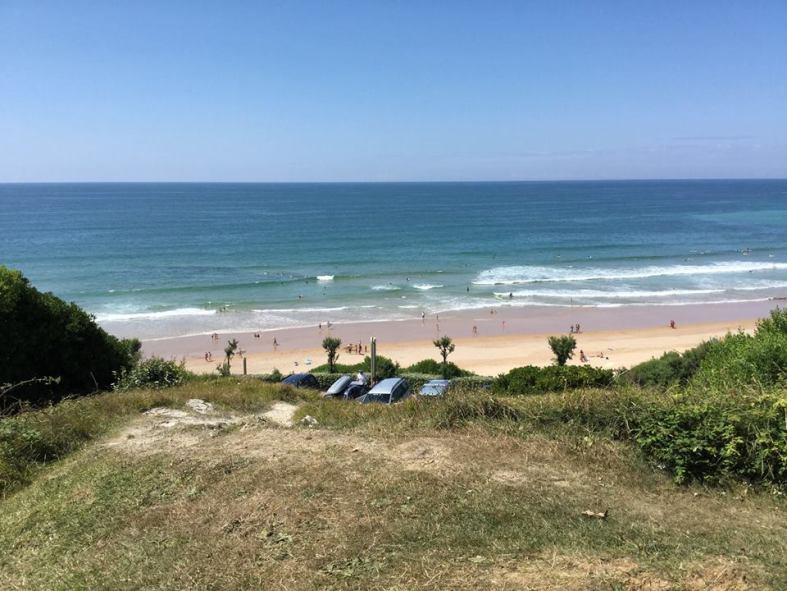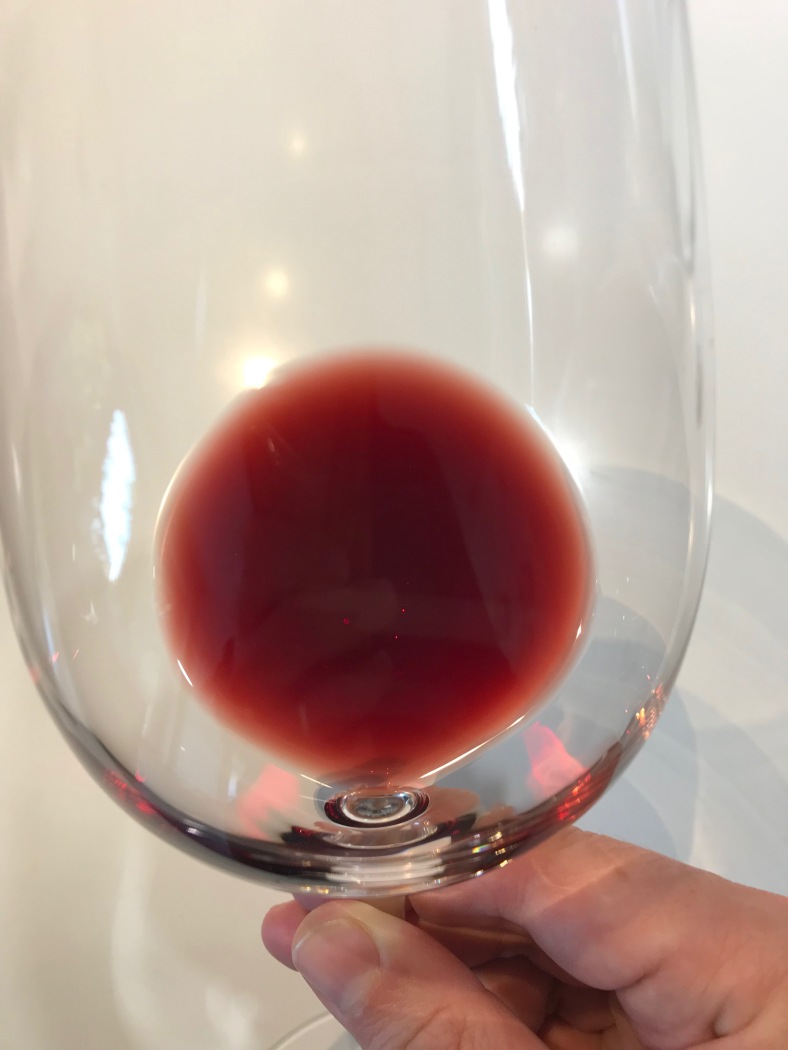I’m joing the #Winophiles this month in their exploration of Irouléguy, a wine region in French Basque Country. I’m very excited about this, as it brings back memories of my hiking holidays in the French Basque Country in 2015. This region is very beautiful, at the foot of the Pyrenees but also on the Atlantic coast, where surf’s up. If you hesitate between the mountains or the sea for holidays, you have both there!

I was hiking in the region with a group, so there was no time to go visiting wineries. But when we were in Saint-Jean-Pied-de-Port, we were given two hours to see the town. I have to admit : I didn’t see town. I took this opportunity to go the winery shop of Domaine Brana instead!
The Brana family was active in the region already since the 19th century, but it was only in the ’70s that Etienne Brana lay the foundations for the current Domaine by starting a distillery. In 1984 he launched himself in the wine business and contributed to putting the AOC Irouléguy on the map. Not that Irouléguy is now known all over the world, or even in France for that matter. There is simply too little wine being produced for that, and finding Irouléguy wine outside France is no simple matter.
It’s for that reason that I bought a mix of Brana’s wines to take home. The whites and rosé didn’t last long, they were simply too good. Nowadays it’s not so unusual anymore to find white Irouléguy, but Etienne Brana made a point of making also white wine of petit courbu, petit manseng and gros manseng (also known from Jurançon) as that was a tradition before in Irouléguy.
His Ilori Blanc 2014 was a very fresh wine with lots of flowers in the nose and a rather high acidity. The Albedo Blanc 2014 was almost completely the opposite, with loads of ripe fruit like pine apple and apricot, a touch of wood and even a bit of honey as it opened up. There was a lovely contrast of ripe and fresh in this wine, the fruit being opulent and the acidity rather in the style of a Chablis. An intriguing wine.
I have a special place in my memories, however, for the Harri Gorri rosé 2014, one of the best rosés I ever had in my life. This was a wine I could sniff on forever, with red currant, strawberries, green herbs and beautiful minerality. Again the profile of this wine was very fresh and precise. Finally a rosé that has its own identity and is more than a white wine with a pink taint! I absolutely loved it. I have spent endless hours looking on the net for a place where I could buy it, but alas…
For the reds Brana also set out to choose his own path, favoring Cabernet Franc over the more common Tannat. Brana argued that Cabernet Franc was a grape that actually originated in the Irouléguy region, and that Tannat is the grape of Madiran. That might have been a smart move. It’s only a few days ago that Peter Dean reported in The Buyer that the Gascogne-based cooperative Plaimont Producteurs is gradually switching to Manseng Noir, as Tannat is producing alcohol levels that are hard to keep under 16°C in recent years.


When I visited the winery shop in 2015 I tasted the Irouléguy Rouge 2010, but back then, it wasn’t fully coherent yet, and the wood was pretty dominant still. Nevertheless I bought two bottles, knowing this was a wine with great ageing potential. I was a little afraid that it would still be too early to open a bottle now, but a quick sniff after opening the bottle made it clear from the start : this is a beauty! Blackberries, blackcurrant, cigar box, graphite, laurel, all jumping out the glass in a beautiful bouquet. Complex like a maze, precise like a Swiss watch, and fresh like a first year student. My fear of sturdy tannins was ungrounded, the structure being velvety instead.
There’s an additional thing that’s interesting here as well. During my sommelier training we always had to discuss a wine systematically, including things such as color and viscosity. The latter is something I nowadays don’t do anymore as I don’t find it very relevant. But from the first sip of this Irouléguy, I immediately noticed that this wine was very concentrated, the viscosity reminding me of a Valpolicella Ripasso for example, but then without the sweetness. Very remarkable! This is a wine with character. Cool climate character by the way. And not unlike certain Bordeaux. That should not come as a surprise, the blend consisting of 60% Cabernet Franc, 10% Cabernet Sauvignon, and 30% Tannat.
It’s still early days to be thinking of lists, but I’m pretty sure this wine will be in my best of 2019 list somewhere. If I think of how it was when I tasted it in 2015, it’s clear this wine has come a long way. This goes to show that we often drink this kind of wines too early. And it’s nowhere near its end. Quite the contrary I’d say. My next, and sadly last, bottle will probably open in three or four years. If only I could find more of Brana’s wines. It’s clear that this is a visionary winery, a flag bearer for the appellation.
Here are the links to the other Winophiles’ posts :
-
-
- Camilla of Culinary Adventures with Camilla shares “A Geography Snafu + Poulet Basquaise with Domaine Illaria Irouleguy 2016”
- Robin of Crushed Grape Chronicles shares “French Poets, Philandering Kings and little sweetness from Jurançon“
- Martin from Enofylz Wine Blog shares “A Match Made in Heaven; Jurançon Sec and Instant Pot Shrimp Boil”
- Jane at Always Ravenous shares “French Basque Rosé Paired with Sicilian Pasta“
- Oliver at In Taste Buds We Trust shares “Domaine Brana : Showing the Way in Irouléguy”
- Cynthia and Pierre at Traveling Wine Profs share “Celebrating the Revival of Irouléguy“
- Gwen from Wine Predator shares “Madiran: French Basque Wine of Pyrenees With Pixtos“
- Payal at Keep the Peas shares “Basque-ing in Irouléguy Wines and More”
- Jeff at Food Wine Click! shares “Basque Chicken and Irouléguy, Perfect Winter Dish on the Hottest Day of the Summer”

Great article on Domaine Brana! We almost got some for today but alas, the distributor after says yes, realized they’d run out. Oh well.
LikeLiked by 1 person
Thanks! Not easy, huh? Same here though…
LikeLike
Thank you for the insights and photos of this region. Picturing the ocean and the steep mountains, really gives me a bit of perspective on the place. Is this wine all Cab Franc…or is it a blend? Your description of it is so evocative.
LikeLiked by 1 person
Thank you Robin! It is mainly cabernet franc (60%), but also cabernet sauvignon (10%) and tannat (30%), At Brana’s they claim that cabernet franc is actually a native grape of Irouléguy. I’m not an ampelographer, so I will not argue about that but it for sure gives good results in Irouléguy!
LikeLike
I love it when my patience with a wine gets rewarded. It sounds like you do too Olivier! I’m also loving that CF is the lead in this intriguing blend! Cheers!
LikeLiked by 1 person
I do! I think cabernet franc also helps to balance the tannins of the tannat. It definitely worked here.
LikeLike